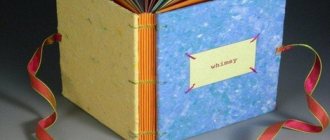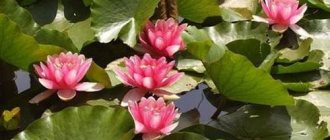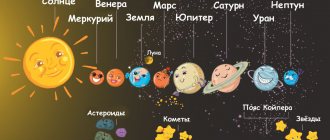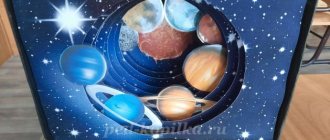Progress of the experiment: For the experiment we will need:
Basin with water;
A sheet of white paper;
Flashlight, mirror.
We pour water into the basin and lower the mirror to the bottom. I turn on the flashlight and direct its light at the mirror. to “catch” the reflected beam
on a sheet of paper.
When a ray of light is refracted, a colored rainbow appears .
Conclusion: A ray of light consists of several colors; when it passes through water, it is decomposed into its component parts - seven colors of the rainbow .
3.2 Experiment II
Progress of the experiment: For the experiment we will need:
triangular transparent prism.
I took the prism in my hands and brought it to the window, the sun's rays began to pass through it, thanks to which a rainbow appeared .
Thanks to these experiments, we can conclude that our hypothesis was confirmed. Rainbow can be obtained at home.
Conclusion: the sun's rays, passing through a prism (as in the case of water, are refracted, that is, decomposed into their component parts - seven colors of the rainbow .
Experiment IV
Project "Rainbow"
It was reflected from her,
Transformed into a Rainbow!
At the last words there was a rumble outside the window. The boy looked out the window and saw that the cloud had broken in two, lightning was falling from it, and rain was pouring down. The cloud was melting before our eyes. When it all melted and the rain stopped, a bright seven-color rainbow stretched across the entire sky.
- Hooray! - the boy shouted. – We defeated the evil witch! We melted the cloud! Hooray!
The rainbow also shouted up there: “Hurray!” Only on the ground it was not heard. But everyone saw the rainbow and were very happy that it had finally returned.
No one knew that she was captured by an evil sorceress. Only Rainbow and the boy knew about this. But they didn’t tell anyone, they just smiled knowingly at each other.
Author: M. Shkurina
“The Tale of How Paints were Painted”
Once we got together to paint blue and yellow paint. They took their brushes, buckets of paint, paper, and went to the meadow.
“I’ll paint the sky,” said Blue Paint and painted a blue sky.
“And I’ll paint the sun,” said Yellow Paint and painted a bright yellow sun.
“I’ll paint a lake,” said Blue Paint and painted a beautiful lake.
“And I’ll draw a little duckling that will pluck the grass near the lake,” said Yellow Paint and drew a duckling.
Then Yellow Paint looked at the duckling, then turned her eyes to Blue Paint and asked:
- And the grass? How will he pluck the grass if we don’t have green paint? Without it, we won't be able to draw grass.
Yes,” agreed Blue paint, “a bad drawing is obtained without Green paint.” It’s a pity that we didn’t invite her to draw with us. What to do?
We thought and thought and did not notice that a cloud had appeared in the sky and a light rain began to fall. They grabbed the paints for their drawing and ran to the gazebo to hide from the rain. In the gazebo they looked at the drawing and saw that the rain had wet it and the colors had flowed. They flowed and mixed with each other. The blue and yellow colors were shifted between each other, and the color green was obtained. Blue and Yellow paints were delighted and began to draw a new picture. Blue paint painted the sky and lake. Yellow drew the sun and a little duckling near the pond. Then they mixed paints from their buckets, and the color they got was green. They drew green grass on which a green grasshopper was sitting. It turned out to be a beautiful drawing.
Then Green Paint walked past them, she saw the drawing and was surprised: “How did you draw it without me?!” Did you understand how?
Author: T. Kulikova
A Tale of a Rainbow.
Once upon a time there lived a little girl Katyusha. She was very inquisitive, everything was interesting to her. Because of this, she always found herself in amazing stories. This time this is what happened to her. One summer day, Katyusha was walking on the street and suddenly saw that it suddenly got dark, a breeze rose, a lot of clouds rolled in, the sun disappeared, and it began to rain. “How interesting,” Katyusha thought, “why is it raining!” Probably because gray clouds covered the sun! As soon as she thought about it, a small drop addressed her. - Hello! My name is Droplet. Let's be friends! I came from that gray cloud over there! - Let's! – Katyusha answered, “tell me why it’s raining?” — It’s raining because the clouds that we see in the sky are made of water, and this water falls to the ground in the form of small droplets! But I want to show you something else, even more interesting! Look! At that moment, the rain stopped, the sun came out, and a multi-colored arc appeared in the sky. She was very beautiful and shone in different colors. - What a miracle! – Katyusha exclaimed. - What is this? - This is a RAINBOW! - said Droplet. — Is it possible to get on it somehow and take a closer look? – Katyusha asked. - Of course, I'll take you there! – Droplet answered and picked up Katyusha. In an instant, Katyusha and Droplet were at the top of the rainbow. She was extraordinary. She had seven colors, one brighter than the other! Katyusha, at all costs, wanted to know the names of these bright colors in which the stripes of the rainbow are painted. And the girlfriends ended up on the very top strip. “This is Red,” said the Droplet; “many objects are painted this color.” The most delicious of them are strawberries, raspberries, cherries, tomatoes, apples. There are also different flowers, butterflies, even red bows in your hair! - This is the color Orange - the Droplet continued, stepping over - this is the color of apricots, carrots, oranges, pumpkins, even freckles on the noses and cheeks of children! — This color is Yellow. It is painted with the sun, stars, some butterflies and flowers, lemons, bananas, melons, and also small chickens, sand and sunflowers! - Take another step, and you will find yourself on a strip of Green - the color of forests, fields, spring foliage, grass, more cucumbers, cabbage and zucchini, gooseberries and watermelon rind. — The next color is Blue. This is the color of the sky, cornflowers and forget-me-nots - This is Blue. The color of seas and oceans, rivers and lakes - And this is the last color - Purple. The color of violets, blackberries, plums, currants and eggplants. - What a pity, Rainbow has run out of all the colored stripes! – Katyusha was upset. - Dont worry! - Droplet hastened to console - after all, everything around you is so colorful, and you will be able to see a piece of the rainbow in everything, and sometimes the Rainbow itself! And now it’s time for me to go to the cloud! - Thank you, Droplet! Come again, I will be waiting for you and will definitely remember all the colors of such a bright and interesting Rainbow! – Katyusha shouted after the flying Droplet. Since then, when a Rainbow appears in the sky, Katyusha’s face glows with happiness, because she has studied all its colors!
Project "Colorful Rainbow"
Research project
"Colorful Rainbow"
Project theme: “Multi-colored rainbow.”
Type of project: creative - experimental.
Duration: long term.
Author of the work: student of the senior group - Anastasia Kachmasheva.
Project manager: teacher of the senior group - Ermolina L.A.
Educational area: cognitive development.
Relevance: The world that surrounds us is beautiful and diverse. But people are paying less and less attention to the beauty and diversity of natural phenomena that bring joy and peace. Everyday worries dull people's natural curiosity and desire to learn new things. Sometimes it seems that people have stopped paying attention even to what is familiar from childhood. Every adult, thinking about a rainbow, remembers his childhood. It was in childhood that I wanted to know what a rainbow is, where it comes from, why it is so beautiful. The task of adults is to stimulate children’s natural curiosity, the desire to make their first discoveries, conduct research, and believe in their strengths and abilities. Research to familiarize yourself with the natural phenomenon of the rainbow is a very interesting and vivid experience that can reveal creativity, initiative and independence in a child.
Objective of the project:
- development of creative experimental and research abilities of children.
Tasks:
- find out as much information as possible about the rainbow as a natural phenomenon;
- learn through experiments how a rainbow appears;
- find information about rainbows in various sources;
- introduce the children of the group to this phenomenon;
- promote the development of research abilities, curiosity and independence.
Hypothesis:
- the method of research and experimentation will help you become more familiar with the beautiful natural phenomenon - the rainbow;
- Rainbows are a natural phenomenon, but they can be created at home.
The role of the child in the implementation of the project:
- participation in the discussion of the topic and goals of the project;
- studying the proposed material;
- putting forward proposals for work on the project;
- participation in collecting materials on the topic;
- conducting research and experiments under the guidance of a teacher;
- active participation in the design of work results (albums, folders, artwork - drawings and crafts).
Role of the project manager:
- ensuring the interest of the child and his parents in working on the topic;
- provision of literature;
- encouraging the child to engage in independent, conscious work;
- constant but unobtrusive assistance and monitoring of the child’s work.
The role of parents in the implementation of the project:
- participation in collecting materials on the topic;
- consultations on the topic;
- participation in experimental activities of children at home.
Expected result:
- the child must receive primary knowledge about the natural phenomenon - the rainbow;
- the child has an understanding of experimental activities and can conduct a number of experiments and experiments himself;
- the child is familiar with the phenomenon of the rainbow and understands its origin;
- the child understands the beauty of a natural phenomenon - a rainbow, and admires it.
Estimated product of project activity:
- Album “Rainbow - Arc” (poems, riddles, signs);
- Album “Rainbow - Arc” (experiments and experiments);
- Creative works (drawings, layouts, crafts);
- Project "Colorful Rainbow".
Project implementation forms:
- Conversation and observations of NOD;
- Experimental and research activities;
- Artistic and visual activities.
Stages of work on the project:
Stage 1: preparatory.
- Discussion of work on the project with the child and parents;
- Determining the topic, goals and directions of work;
- Development of a plan for working on the topic;
- Selection of fiction and methodological literature;
- Purchasing the necessary video materials.
Stage 2: main.
- A series of conversations;
- Acquaintance with poems, riddles, folk signs;
- Watching videos demonstrating a natural phenomenon - a rainbow;
- Reading and viewing encyclopedias;
- Experiments on making rainbows at home;
- Artistic creativity - creating drawings, models, crafts.
Stage 3: final.
- Summing up the work;
- Design of the album “Rainbow - Arc” (poems, riddles, signs);
- Design of the album “Rainbow - Arc” (experiments and experiments);
- Exhibition of creative works on the theme “Multi-colored rainbow” (drawings, layouts, crafts);
- Design of the project “Multi-colored rainbow”.
- Defense of the project at the municipal stage of the “I am a Researcher” competition.
Progress of the experiment: For the experiment we will need:
CD;
flashlight.
I took the CD in my hands and began to direct the beam of the turned-on flashlight at it. A sunbeam appeared on the wall , but with a certain rotation of the disk, the wall was painted in different colors - a rainbow appeared .
Conclusion: Light is refracted on the mirror surface of the disk, similar to the refraction of sunlight in a drop of water. That's why we can see a rainbow .
3.3 Experiment III





